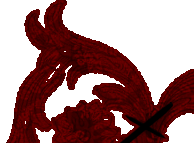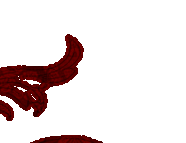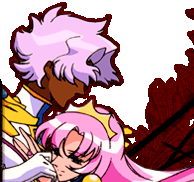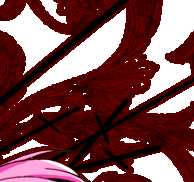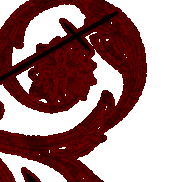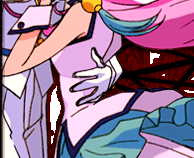
This analysis
was donated by Cat. They say goldfish have no memory
I guess their lives are much like mine –
And the little, plastic castle
Is a surprise every time.
- Ani DiFranco
In reality, what difference is there
between a flower and our imagining one?
There is none truly, for the world is a living
pulsation,
And the pulsation is in everything.
- Mahesvarananda Once upon a time, years and years ago, there was a little princess who was very sad, for her mother and father had died. Before the princess appeared a traveling prince riding upon a white horse. With a regal bearing and a kind smile, the prince wrapped the princess in a rose-scented embrace, and gently wiped the tears from her eyes. “Little one who bears up alone in such deep sorrow, somehow, never lose that strength or nobility, even when you grow up. I give this to you to remember this day.” “We’ll be able to meet again, won’t we?” “This ring will lead you to me, one day.”
Perhaps the ring the prince gave her was an engagement ring. This was all well and good, but so impressed was she by him, that the princess vowed to become a prince herself one day. But was that really such a good idea?
With these beginning and oft-repeated words, the Japanese animation (anime) series Revolutionary Girl Utena establishes itself as a myth – as, in the words of Douglas Brooks, “a self-conscious lie told in the service of a deeper truth” (Brooks, Sept. 2). By setting itself up “once upon a time,” in a reality that is and is not our own, Utena begs not factual analysis but mythical interpretation, challenging the viewer to make sense of its fragmented impossibilities by supplying a meaningful lens. An examination of this series in the light of Hindu and Buddhist thought unearths an implicit allegorization of the debate between these two philosophies/religions (the Sanskrit term makes no distinction) on the ontological status of the Self.
To Buddhists, the Self is a construction, a projection of ignorance, that lacks any enduring identity or essence. Far from affirming an essential core, a unique “I” who experiences the world and provides continuity and stability, Buddhists state that everything in existence arises through a web of entangled, co-dependent processes devoid of beginning, end, essence, or identity. This deconstruction of the self is aimed squarely at Hindu orthodox tradition at the time of the Buddha, himself a Hindu warrior/prince who rejected and subverted Hinduism. In the course of debates between the two systems, however, some Hindus came to appreciate Buddhist critiques of uniqueness and definition of identity as a process of expansive interconnection. Drawing on foundations in the Upanishads, the last of the Vedas, Hindu thought absorbs Buddhist arguments by showing that the complex web of manifestation points back to a deep, common essential origin. This essence is brahman, the expansive core reality fractally reproduced in atman, an individual self or soul. Like emerging Hindu thought, Utena passes through and beyond a Buddhist metaphysic to emerge in a revelation of the upanishadic Self via an unearthing of the One “hidden in the cave of the heart” of Himemiya Anshii (Olivelle 233).
To establish the stakes of this debate and show how Utena reasserts the existence of the Self from within a world dominated by Buddhist metaphysics, I will first explore the Madhyamaka philosophical tradition of Buddhism and establish Anshii’s brother Ohtori Akio as a failed bodhisattva who constructs the world as an anti-essential, nihilistic power struggle. Though the viewer does not meet Akio until much later, her initial understanding of Anshii is radically shaped by his influence; I will show how Anshii’s dissimulation as the Rose Bride is a result of Akio’s manipulations through Buddhist metaphysics. However, Anshii’s relationship with Tenjou Utena, the story’s title character, slowly extracts Anshii from Akio’s influence, ending in a rediscovery of Anshii’s own self. Thus the final episode allows the story to be retrospectively read as an allegory of divine awakening to self-consciousness.
Before we can revel with the divine, perhaps some of the stranger aspects of Utena warrant as short description to avoid confusion later on. The series moves through a procession of sword duels for possession of the Rose Bride, Himemiya Anshii, who becomes engaged to whomever wins the duels. Tenjou Utena, a girl who dresses like a boy to feel closer to the prince she met as a child, stumbles into this system when she challenges the then-current Engaged One to a duel because he insulted her best friend. The duels take place on a platform at the top of a loooong spiral staircase inside an elaborate gate which opens when a drop of water falls on the Rose Crest, which all duelists wear. A castle said to hold eternity floats magically in the sky above this Dueling Arena. The Engaged One fights with the Sword of Dios which is drawn literally out of the Rose Bride’s chest; later, all Duelists fight with swords drawn out of someone’s chest.
 Soulless Bodies and Castles in the Sky: An Introduction to Buddhist Metaphysics When asked who receives the fruits of karma, the Buddha replied: “I have taught you, O bikkhus, to see conditionality everywhere in all things” (Rahula 66). This is the insight of pratityasamutpada, often translated as “Conditioned Genesis,” “interdependence,” “dependent co-origination,” or even simply as “relativity,” which states that everything in existence arises through a process of interdependent co-origination with no beginning, end, or essence. Thus to see “the conditionality of all things” is to see anatman, or no-Self – to see that all dharmas (tiny, fleeting thought-moments that serve as the building blocks of reality; often translated simply as “things”) lack svabhava (essential, intrinsic, unchanging self-existence). In his Stanzas on the Middle Way, the great philosopher Nagarjuna, founder of the Madhyamaka, or “Middle Way,” school of Buddhism, expands on why reality as we know it would be impossible if dharmas indeed possessed an inherent essence: “If you view the true existence of existing things from the perspective of each thing having its own inherent self-existence [svabhava], you will necessarily see those existing things as having neither cause nor condition, as being totally unrelated to anything else” (Strong 148). As John S. Strong explains in an introduction to Nagarjuna’s thought:
Because ‘things’ (dharmas) are empty of any inherent, separate, unchangeable, permanent, essential self-existence (svabhava), it is possible for relativity, for interdependence, to occur…If ‘things’ were not empty, that is, if they did have svabhara, it would be impossible for them – for their ‘essence’ – to change, interact, or grow, because their ‘essence,’ their ‘inherent nature,’ what makes them ‘them’ is by definiton unchangeable, separate, and permanent (Strong 146).
This conception of “emptiness” (sunyata) is key to understanding Buddhism’s attack on the existence of atman, for Buddhists point out that meaning and identity are produced expansively through relationships.
For example, to say “I am myself” says nothing about me; my identity only has meaning in relation to other people and ideas – and only my ability to relate with and connect to things outside of myself allows me to have an identity in the first place. Taking this analysis a step further, Buddhists posit that if anything really were unique – really itself and in no way influenced by anything else – we would not even be able to recognize it, for all recognition is based on connecting new stimuli by metaphor to what we already know. This metaphorical connection imposes two constraints on human knowledge: what we know must always be in relation to what we already knew before, and we cannot have any direct access to the thing-in-itself, a fantasy whose existence Buddhists deny outright.
Nietzsche provides a useful reference point in his short essay On Truth and Lies in their Extra-Moral Sense as he states, “If [man] does not wish to be satisfied with truth in the form of a tautology – that is, with empty shells – then he will forever buy illusions for truths. What is a word? The image of a nerve-stimulus in sounds. But to infer from the nerve stimulus, a cause outside of us, that is already the result of a false and unjustified application of reason,” and continues, “What, then, is truth? A mobile army of metaphors, metonyms, and anthropomorphisms…illusions about which one has forgotten that this is what they are” (Nietzsche 45–47). Buddhists push these conceptions one step further by insisting that since illusions and metaphors are all we can know, they are all that is. As Malcolm David Eckel states in his book To See the Buddha, explaining Nagarjuna, “It is precicesly because things are unreal ultimately that they are real conventionally” — the lack of inherent essence is exactly what allows anything to participate in a framework of meaning and interpretation (Eckel 36). Seeking atman is thus the cause of suffering because one seeks for something that never was and indeed cannot be. On the converse, insight into reality as pratityasamutpada gives the bodhisattva (being destined for enlightenment who chooses to remain in the manifest world to lessen the suffering of others) immense powers over these illusions. As Nagarjuna writes, “Everything is possible for someone for whom Emptiness is possible. Nothing is possible for someone for whom Emptiness is not possible” (Eckel 36).
Through intense study and meditation, a bodhisattva comes to such a deep understanding of the processes of karma (causality as momentum and action) and illusion that constitute the world that s/he can manipulate these forces to change how reality manifests. As Strong explains, “At this point…adepts are ready to develop so-called supernatural, or “magical,” powers such as walking through walls, diving into the earth, walking on water, or flying through the air” (Strong 125). Buddhist mythology is also full of stories of Buddhas and bodhisattvas who manifest entire worlds, even cause people to live whole lives, for the sake of leading others to enlightenment (Eckel 11-20). As Eckel states, these stories “show that the most powerful sages are not the ones who flee the structures of illusion but are those who posess the knowledge to manipulate it and bring it under their control” (Eckel 16). Eckel chronicles the thought of Madhyamaka philosopher Bhavaviveka, who speaks of reality as structured as a palace manifest through “a great bodhisattva’s illusion-making power.” As Eckel states, “[T]hese palaces demonstrate the delicate and shadowy line that separates illusion from reality” (Eckel 17). The parallels to the castle that appears in the sky over the dueling arena in Utena are striking and help establish Akio as a bodhisattva who, despite renouncing his compassionate vow, still retains much of his power.
 No Sword Behind the Sword: Applications of Buddhist Metaphysics in 'Utena' Like Bhavaviveka’s palaces, the castle in the sky in Utena uses the conventional constructs of illusion and reality to posit that there is nothing behind the illusion; it is the only reality that exists. When Utena first sees the castle, Saiyonji Kyoichi, her first opponent, tells her that it’s “a kind of mirage. Think of it as a trick of the light” (Vol. 1, 16:04-16:08), thus dismissing the castle as nothing but a projection. As the castle appears and disappears under different circumstances, this view seems rather logical. However, Anshii says about the castle, “Something eternal dwells inside it” – within this “trick of the light” lies eternity, what is really real (Vol 2, 33:46-33:48). Thus reality is said to lie within an illusion – or reality is nothing but the illusion, manipulated for reasons the Duelists do not know.
Indeed, when Akio duels Utena in the penultimate episode, he tells her “In the end, both the prince and the castle where eternity dwells are just illusions” (Vol 10, 33:23-33:27). Akio himself is the force behind these manifestations: “I can project fairy-tale illusions for the naïve people who wish that ‘eternity’ and miraculous power really exist” (Vol 10, 34:38-34:45). He further reiterates that reality is only this power struggle; speaking of the Chairman’s Office, the room from which he spins his illusions, he states, “[T]here is no place higher than this room. This room is the summit of Ohtori Academy…The summit of the world itself” (Vol 10, 34:46-34:56). Akio thus demonstrates the powers of a highly advanced bodhisattva, but far from being a compassionate savior, he uses his illusions to trick others into participating in a highly dangerous and psychologically-damaging system whose end is his own recovery of the Power of Dios, the mythical power of the Prince that Akio once possessed.
Once, long ago, Akio was the Prince – a true savior who protected all the girls in the world from whatever danger they imagined themselves to be in. The “Tale of the Rose” play enacts the story of the Prince, as society understands it at least, through the faceless shadows of actors who remain hidden behind a screen, foregrounding how all meaning is a willful projection onto images that are themselves merely outlines. This play tells Anshii and Akio their own story, casting them into the mystic roles of witch and prince. As Strong states of the role of savior bodhisattvas, “[B]eing saved did not just mean being guided or goaded into a better understanding of the perfection of wisdom; it also meant being rescued from specific situations of suffering – from monsters, murderers, shipwrecks, and the like” (Strong 179) The play dramatizes this aspect of the bodhisattva/Prince when a girl screams, “Help me! It’s Christmas Eve and I’m all alone!,” and the Prince replies, “Fear not! I have reserved a table for us at a French restaurant!” (Vol 9, 6:47-6:57). Society thus casts Dios as the entirely selfless protector of all the girls in the world, and is perfectly content to rely endlessly on the Prince. Thus Anshii’s act of sealing the Prince away is portrayed as an entrapment, motivated out of jealousy, “all so darkness could reign” (Vol 9, 8:36-9:45).
Under this misunderstanding of the Rose Bride as “witch,” Anshii deepens the Buddhist allegory through her dissimulation in becoming whatever her master, the current winner of the duels, desires she be. As Saiyonji’s bride, she plays into his desire for power by assuming the form of a powerless victim, responding to both physical and mental abuse simply with “Forgive me, Saiyonji, my master” (Vol 1, 17:21-17:23). She plays into Kaoru Miki’s, another Duelist’s, desire to angelicize her into the innocence and purity Miki feels he lost as a child through her piano playing and frequent, sweet smiles (Vol 1, ep. 4-5); later, to edge Miki toward dueling again, she seduces his father to deepen his distrust of adults - and manages to keep secret from him that she is his “new mother” (Vol 6, 56:30). These are but a few examples of Anshii’s dissimulation, which illuminates the motivation behind nearly every interaction she has with other characters, particularly in the first two arcs. Indeed, Anshii assumes her new roles so seamlessly that the Engaged One often does not even realize that the Anshii they know is simply a mirror of their own desires.
Kiryuu Touga, President of the student council and the End of the World’s number-one lackey, drives this point home when he wins a duel, temporarily separating Anshii and Utena. As Touga turns to leave, Utena call after him, “Wait…Don’t take Himemiya away, please. She wants to be an ordinary girl again. I have to do that for her… Himemiya needs me!,” to which Touga replies in disdain, “You don’t understand anything.” Utena persists: “It’s true. She said she wants to make more friends! If I leave her, then she’ll be all alone again!” At this point, Touga stages a performance of the Rose Bride’s performativity:
Touga: Anshii.
Anshii: Yes?
Touga: You’re happy being the rose bride, aren’t you?
Anshii: I…[glancing conflictedly at Utena for a moment, then smiling] I am happy being the Rose Bride.
Touga: You don’t need friends. You like being alone.
Anshii: Yes, I like being alone.
Touga ends by saying, “Tenjou-kun, don’t you see? Himemiya Anshii is the bride of whomever wins the duel. While she was engaged to you, she was only following your commands…The rose bride answers her master’s wishes. The wish to make her a normal girl was merely your own wish” (Vol 2, 1:31:35- 1:33:14). This eerie ability to assume whatever role necessary to keep her master interested in both her and the duels, and thus forward the dueling game, shows Anshii as nothing but a fragmented series of appearances, playing directly into Buddhist deconstructions of Self.
As the 5th century philosopher Buddhagosa writes, “Mere suffering exists, but no sufferer is found; the deeds are, but no doer is found” (Rahula 26). Nietzsche once again provides a useful perspective in his oft-quoted passage from The Genealogy of Morals; speaking of a “neutral substratum” from which one can choose to express oneself or not, he states, “But there is no such substratum; there is no ‘being’ behind doing, effecting, becoming; ‘the doer’ is merely a fiction added to the deed – the deed is everything” (Nietzsche 45). Anshii thus stands as the ideal embodiment of the conception of no-Self: a “doll without a heart” who “has no will of her own” (Vol 10, 30:38-30:39; Vol 6, 40:44-40:46). Judith Butler picks up on this conception when she defines gender as performative, “constituting the identity it is purported to be,” for “gender is always a doing, though not a doing by a subject who might be said to preexist the deed” (Gender Trouble 33). By (re)expanding Butler’s concept of gender performativity to apply to identity formation as a whole, Butler’s insight shows Anshii as “a kind of imitation for which there is no original” (“Imitation and Gender Insubordination” 21). Hence, this emptily-reiterating vessel of eternal suffering, behind which “no sufferer is found,” defines what it means to be the Rose Bride.
Utena first meets both the Rose Bride and the Prince as a young child on the eve of her parents’ death in a car accident. Depressed and disgusted with life, Utena hides in an empty coffin. When Touga and Saiyonji stumble upon her, she refuses to come out, saying, “Living on…is just making me sick…Why does everyone go on living if the all have to die someday? Why didn’t I realize it before today? That there’s no such thing as something eternal” (Vol 2, 32:01-32:26). Unable to show Utena anything eternal, the two leave, but Utena soon has another visitor. Dios finds Utena in her coffin, and, intrigued by the Prince’s beauty, Utena follows him to a dark cavern where the Rose Bride dwells. Silhouetted but for gleams on the innumerable swords pierced through her body, Anshii is suspended against a fractured pale red backdrop that looks like a rose pulled apart from the inside out. “I envy those who can die,” Dios says, as the camera pans to a close up of Anshii, whose head rolls eerily in torment. “She cannot die. She simply lives on in agony,” a punishment for withholding her brother, the Prince, from the angry mobs of humanity who demanded his services. Seeing Dios so badly wounded that he would surely die if he continued to fight, Anshii confronts the mob massed outside their cottage, saying “Dios is no longer here! He belongs to me alone now. I’ve sealed him away where you can never touch him again!” The mob then turns on her, skewering her with the “thousand swords of humanity’s hatred”: thus the Rose Bride is born. Even though she “sacrificed herself for the one she loved,” as Dios tells Utena, “[T]he prince she loves is no longer the prince she knew. Not anymore. He is now the End of the World.” Overwhelmed with rage and despair, Dios splits into two: Akio, whose name, a derivative of the Japanese name for the Morning Star, means both “Venus” and “Lucifer,” and the wandering disembodied spirit who speaks with Utena.
On this night Dios does indeed show Utena something eternal and thus gives her the strength to continue living, for Utena vows to become a prince to end the Rose Bride’s eternal suffering. This view of life as defined by suffering, and embodiment only justified in the attempt to deliver others from their torment, fits squarely with the myth of the Buddha and other future bodhisattvas. Confronted by the sights of old age, sickness, death, and an ascetic, the Buddha leaves his life as a warrior/prince in an attempt to figure out how to end suffering, and his first Noble Truth affirms that life consists of suffering. Thus, the series establishes both Akio and Anshii as disembodied selves split from identities they never even held in the first place, manipulating the web of appearance in a desperate bid to end their own suffering that neither really believes will succeed. Akio recodes his fall in terms of the Buddhist claim that one cannot loose the Self, for one never had a Self from the start when he says to Utena, “Foolish creature! There never was a prince in this world to begin with” (Vol. 8, 38:15-38:25).
A number of structural points also foreground Buddhist aspects of Utena. The series relies heavily on repetition; indeed, the format of the duels itself is highly regular, and Anshii and Akio have apparently restarted the rules of the Rose Seal many times (1:06:34-37). Within this large structure of repetition, many individual scenes repeat frequently: the initial flashback sequence when Utena meets her prince as a child ; the chick speech from Hesse’s Demian repeated by members of the Student Council; Utena’s ritual ascent to the dueling arena; the drawing of the Sword of Dios; Mikage’s “interviews” in his descending elevator; the Akio car scenes; and the motif of Anshii and Utena’s hands separating. This repetition shadows the never ending cycle of samsara, the process of being swept away by the current of death and rebirth. Especially from Akio and Anshii’s perspectives, humans seem to do the same stupid thing over and over again. However, as these scenes repeat, they begin to evolve; small changes build upon each other to transform both the visual images and the viewer’s understanding of the scene. These repetition-with-a-difference is one of the viewer’s first hints that there may be something more behind the illusions and shadow plays of Akio’s world.
 U R I R 1: The Hindu Revelation of Self Buddhism’s most compelling critique of the impossibility of the ontological existence of an independent, essential Self is through its analysis of identity as expansive: if anything were truly unique, it would be meaningless and have no connection whatsoever to anything else. This analysis, however, does not touch the upanishadic vision of Self, for the Upanishads posit that the individual Self is a fractal manifestation of brahman, the expansive One who both is and creates all existence. As the Brhadaranyaka Upanishad states, “As a spider sends forth its thread, and as tiny sparks spring forth from a fire, so indeed do all the vital functions, all the worlds, all the gods, all beings spring from this Self” (Olivelle 26). Krishna, avatar of Vishnu, further elaborates in the Bhagavad Gita, stating “Brahman is the offering, brahman is the oblation that is poured into the brahman fire by brahman: he who thus contemplates the act as nothing but brahman must reach brahman” (van Buitenen 89). Informed by this conception of the deep, hidden identity underlying manifestation, Hindus push the critique of uniqueness one step further by pointing out that if, as Buddhists say, identity is formed only through connections, there must be a common source or essence underlying manifest reality for us to have an experience of anything at all.
Douglas Brooks employs the analogy of a prism dividing a ray of light into its constituent colors to explain how manifest diversity points to a deeper, common source. When a prism divides light, distinct colors emerge. If one were to stand, for example, only in the refracted beam of red light, one would not be able to experience all the other colors, or if one did, s/he would experience them as separate. However, by looking at the nature of light itself, one realizes that different colors correspond to different wavelengths, and that all the colors are contained in the white light from which the prism divided them . In this sense, brahman is white light, consciousness is the prism, and normal experience is standing in only one color (Brooks, Oct. 19). Therefore, surface realities manifest for reasons that are not immediately apparent but can be unearthed through close examination. As stated in the Brhadaranyaka Upanishad, “This same self (atman) is the trail to the entire world, for by following it one comes to know this entire world” (Olivelle 15). Yoga, literally “yoked,” refers to holding both versions of reality within one’s mind at the same time – to gaining deep understanding of the universe not in an attempt to resolve the paradoxes of one and many, change and eternity, good and evil, but to realize that the universe itself manifests as levels of embedded paradox.
But if everything is One, why do we experience it as many in the first place? If I am God, why would I mask my own identity from myself? Branching off of insights from the Upanishads, Tantric Hindus answer these questions with a deceptively simple answer: The One eternally changes into itself because it wants to – because diversity is more interesting than unity. The universe is thus one Self continually concealing and revealing itself to itself because the joy of recognition and the sorrow of loss, all the myriad emotions and perceptions flowing through this universe, including the moment of quiet stillness when one recognizes the Other as the Self, are the most fascinating and fulfilling experiences one can have. As the One is consciousness, the creative power that defines experience via the lens it chooses to look through, its essence must be volition and understanding, so of course it must have a reason to manifest itself diversely, and that reason must be that it’s more interesting to experience oneself as many than as one. This insight springs directly from the creation myth of the cosmic man in the Upanishads, who splits himself first into two, and ever further divides into more and more beings, so the One can have the joy of experiencing itself (Olivelle 13–15). According to Brooks, “Unlike other nondualist traditions, in which the created universe is considered a mere illusion manufactured by maya or a mere product of human ignorance, Shakta Tantrism maintains that the universe is itself a real form of divine Consciousness” (Brooks 96). Thus although this system ideally produces difference without alienation, the Tantricas explain even alienation and ignorance. These negative experiences are also experiences, and so also necessary both to see their counterparts and as experiences in their own right.
Through this treatment of opposites, the Tantricas return to the earliest insight of the Vedas: the universe is a symphony ever vibrating between presence and absence. But presence and absence are not really different; by making the universal fabric of “is” and “is not” consist of a Self-imposed distinction between “remembering” and “forgetting,” the Tantricas bring unity and intelligibility to the universe. As Tantric thinker Mahesvarananda posits in his “Garland of Great Meaning,” “The reflective difference between existence and non-existence is like that of emerald and ruby side by side: a single essence is merely the unfolding reflection of the two, a confluence of pulsations” (Brooks). Like the inhalation and exhalation of breath, the world consists of remembering and forgetting turning constantly into each other, and of the space between – the tiny space between breaths that is knowledge and recognition.
The beautiful 12th century poem Gitagovinda, translated by Barbara Stoler Miller as Love Song of the Dark Lord, provides another striking example of this play. Since the divine seeks to know the full range of human emotion and experience, Krishna as a young cowherd and Radha, a cowherdess, perform a complicated dance of separation, longing, and reunion. Far from showing that Radha forgives Krishna and agrees to take him back even though he’s cheated on her, the text dwells on the beauty of separation as well as the bliss of union, positing that suffering is just as beautiful as love. This insight is informed by the realization of the ultimate identity of the divine, the universe, and the individual – since everything is brahman, there is no reason to fear any aspect of experience, nor is there a possibility of true separation. Thus since all experience is divine, spiritual liberation comes from accepting God’s invitation to play, and seeing the beauty in all moments of creation.
Radha’s suffering, as well as Krishna’s, is not portrayed negatively as an obstacle to be overcome, but forms an integral part of the experience of the divine. In a move that both complicates the distinction between inside and outside of the text by fictionalizing himself into the story, thus positing the unity of creator and creation that defines brahman, Jayadeva constantly reiterates the beauty of Radha and Krishna’s longing, both through the care and skill by which he renders these emotions and, more specifically in the sections where he calls attention to himself as author. In Fourth Part, after describing Radha’s intense passion and sorrow, Jayadeva writes, “If your heart hopes to dance the haunting song of Jayadeva,/ Study what her friend said about Radha suffering Hari’s desertion,” thus foregrounding the necessity of appreciating darker emotions if one wishes to understand the divine (Miller 87). As Radha herself states, “My heart values his vulgar ways,/ Refuses to admit my rage,/ Feels strangely elated,/ And keeps denying his guilt” (Miller 80). Here she realizes that Krishna’s love is far more valuable when, having experienced the whole of the world, he decides to return to her. Just as suffering deepens one’s ability to feel joy, an open relationship deepens the meaning of freely-chosen faithfulness.
Thus the text shows that while the divine cannot be forced, it will offer itself to one willing to accept it in its entirety. As Krishna says to Radha, “Lovely fool, I am here as your lover:” divinity always invites participation through the depth of human experience (Miller 114). Jayadeva writes the poem in rich language inviting the reader to linger and drink deeply of both the haunting beauty of Radha’s torment and the ecstatic joy of her triumph over her lover – for this very lingering appreciation of the beauty of creation is itself the key to spiritual liberation.
Armed with this insight that brahman manifests the universe for the joy of its own experience, I will now turn to the final episode of Utena and show how a close examination retrospectively reveals the series as passing through Buddhism’s framework to reveal the divine dance of separation and reunion.
 Someday, We’ll Shine Together: Discovering the Self in Anshii During Akio and Utena’s duel, Utena manages to resist both Akio’s physical and psychological onslaughts and, remembering Anshii’s attempted suicide the night before, vows to free Himemiya from Akio. When Akio asks Utena if she understands what she’s saying, she replies, “I understand! It means I’m going to become the prince!” (Vol 10, 43:05-43:23). At this point the already fragmented dueling arena begins to crumble in all earnest, and the Grave of Dios, a monolith resembling a ceramic egg with Dios slumped on the side, crumbles to reveal the Rose Gate which contains the passage to eternity. Utena takes advantage of Akio’s confusion, and for the first time seems to have the upper hand. However, as Anshii watches the duel, her eyes grow wide and begin to tear, for she really does know what will happen to Utena if she becomes the Prince – Utena will fall into the same eternal suffering that Anshii now experiences. Akio notices Anshii’s mood and thrusts her at Utena, surreptitiously handing her his sword; Utena steps in front of Anshii to protect her. Her face moving from shock to deep sadness, Anshii closes her eyes, embraces Utena – and plunges the sword into her back (Vol 10, 43:24-45:00).
As Akio approaches the Rose Gate, the thousand swords of humanity’s hatred gather in a giant pyramid; Akio summons Anshii to fulfill her role as the Rose Bride and take the swords for him. The final dueling song, a multivalent slow and eerie chant, starts to this image of the gatherings swords; a refrain of “Missing Link” echoes as Anshii offers herself up for the sacrifice. As Utena watches in horror, the swords circle around Anshii, then plunge mercilessly into her to the refrain, “The lost link in the chain...I am disconnected, though I have the power to join.” Utena pulls herself along the floor, screaming Himemiya! “I did not want to be born…and yet I was born all the same” as Akio attempts to break into the Rose Gate with the Sword of Dios. “Though it marks my beginning… My birth leads to my death. My birth leads to annihilation.” Each time Akio strikes the gate, Utena reacts as if she’s been hit; desperately, she tries to get up, calling for Akio to help Anshii, “The repetition, so absurd…”
Unable to stand, Utena lies twitching on the ground when Dios appears suddenly and tells her not to move, lest she hurt herself further. Dios then appears on a carousel and says to Utena, “Such a gentle hearted girl…You weep for her?” as the song continues “I am disconnected…and yet I am still connected.” Dios continues:
Dios: You see that rose-shaped gate over there? (image of Akio banging at the gate)
Song: See, I have vanished
Dios: Through that door lies eternity…With that power, anything is possible.
Song: …yet I still sing
Dios: It’s too much for you.
Song: See, I have vanished…
Dios: You’re just a girl, aren’t you?
Song: …yet I still smile
Dios: And so, you will not have that power
Song: See, I have vanished…
Dios: If you had it, you could do anything. You could free that girl from her destiny.
Song: …yet I am petrified
Dios: But how that power shall be used…
Song: See, I have vanished… (Dios disappears from the carrousel, replaced by Akio)
Akio: I decide.
Close-up of Utena’s face against the floor, hand with her Rose Crest laying in front of her mouth
Song: …yet I still live
Utena looks up, and sees Dios kneeling over her
Song: I still exist
Dios: Come now. Don’t look so sad.
Song: I—still -- exist ((missing link)))
Dios: You’ve tried so had till now. No need to blame yourself.
Song: I am still here
Dios: You’ve treasured your Rose Crest until now.
Song: I still exist (Close shot of Utena’s hand with the ring)
Dios: A kiss, to show my appreciation…
Song: I – Still – Exist - (Dios moves in to kiss the ring)
Dios: This is the only comfort I can offer.
Song: I am still here — I-Am-Still-HERE!
Utena punches the ground where Dios’ face was a moment ago to the refrain “missing link; missing link…,” and slowly forces herself to stand. The camera focuses on her profile, eyes scrunched closed in effort, dripping with sweat as she raises her face. Eyes open; she stands, shadows of the swords falling on her as the song fades, chiming “missing link…” (49:00-56:43).
In the song is the key to understanding this sequence; songs in the duels generally mirror the consciousness of the duelists. By moving from dejected nihilism to the realization that “I still exist,” it traces the entire story in a microcosm. The “missing link,” of course, is Utena’s own Self, who refuses to be consoled into inaction. The lyrics, “See, I have vanished…yet I still sing…yet I still smile” show Utena’s budding realization that even in the apparent absence of the Self, something shines through to point to its presence. Given the strength to stand again by this realization, Utena staggers to the Rose Gate; clinging desperately to the vines wrapped around it, she looks up at Anshii, by now almost invisible under the swords. “Himemiya…you still don’t know…,” she whispers, trembling against the gate, “How happy I was just to be with you.” A tear mingles with the sweat on her face and falls, triggering the same water-drop sequence that opens the gate before every duel – and the Rose Gate opens, revealing a coffin.
The screen goes black, and a tiny voice in the darkness calls, “Himemiya…Himemiya…” A small slit of light reveals Anshii, asleep deep within the coffin. Anshii’s voice, sounding like a child, asks, “Who’s there?,” to which Utena’s voice, also child-like, responds, “I came to save you.” As the slit of light grows larger, Anshii asks again, “But…who are you…?,” and Utena replies “I came all this way to be with you. So don’t be afraid of our meeting, of this world.” The light overwhelms the screen, and when the flash clears, we see Utena, tears streaming down her face, hands bloody, calling Himemiya’s name as she clutches the coffin door she’s dislodged. At first looking dazed, as if just awaking from a very long sleep, Anshii murmurs “Utena-sama,” then, realization dawning, cries “Utena-sama!” Utena urges Anshii to take her hand; Anshii hesitates, knowing that the swords will turn on Utena if Utena doesn’t leave immediately. Finally, though, the two tenuously join hands – and the platform crumbles, plunging Anshii into the abyss as their hands are forced apart. Just as Anshii predicted, the swords then turn on Utena, who is too absorbed in her own grief to even notice their coming (1:00:49-1:03:55).
Life then seems to return to normal at Ohtori Academy; most of the students forget Utena ever even existed, and Akio prepares to restart the rules of the Rose Crest, considering Utena a failure. Anshii, however, says to him, “You really don’t know what’s happened, do you? It doesn’t matter anymore. By all means, stay in this cozy coffin of yours and continue to play prince as always. But I have to go now,” and turns to leave. When Akio calls after her, Anshii says “That person isn’t gone at all. She’s merely vanished from your world.” Bells tolling, Anshii leaves the Academy, thinking “This time it’s my turn to go. No matter where you are, I swear I’ll find you. Wait for me…Utena,” and the series thus launches into the final song and credits. However, although it appears the series is already over, after the credits an photograph of the two appears, with Utena’s voice saying, “Listen, if you ever have a problem, come to me first. I want us to be friends like that. And someday, together…,” and Anshii’s voice continuing, “Someday, together…?” After a brief image of the two’s hands clasped, the screen reads: “Someday, together, we’ll shine” (1:04:24-1:09:45).
 The final episode thus establishes Utena squarely within the Hindu myth of the separation and reunion of the divine, passing through Buddhist denials of Self to end in an affirmation of all experience as the joy of manifestation. As Anshii sets out on her new journey, she shows that in the possibility of repetition-with-a-difference granted by embodied life, the journey to find Oneself is as beautiful as the reunion itself.  Bibliography Brooks, Douglas Renfrew. The Secret of the Three Cities. University of Chicago Press: Chicago , 1990.
---. “REL 105: Asian Search for Self.” Lecture notes. University of Rochester. September 9, 2004 – December 9,
2004.
---, trans. The Maharthamanjari or the Garland of Great Meaning of Mahesvarananda. Unpublished.
Butler, Judith. Gender Trouble. Routledge: New York, 1999.
--- “Imitation and Gender Insubordination” in Inside/Out: Lesbian Theories, Gay Theories. Routledge: New York,
1991.
Eckel, Malcolm David. To See the Buddha. Princeton University Press: Princeton, NY, 1991.
Lawrence, David Peter. Rediscovering God with Transcendental Argument. State University of New York Press:
Albany, NY,1999.
Miller, Barbara Stoler, trans. Love Song of the Dark Lord: Jayadeva’s Gitagovinda. Columbia University Press:
New York, 1977.
Nietzsche, Friedrich. On the Genealogy of Morals. Vintage Books: New York, 1957.
--- “On Truth and Lies in their Extra-moral Sense” in The Portable Nietzsche. Penguin Books: New York , 1982.
Olivelle, Patrick, trans. Upanishads. Oxford University Press: Oxford, 1998.
Rahula, Wapola. What the Buddha Taught. Grove Press: New York, 1974.
Revolutionary Girl Utena . Dir. Kuniho Ikuhara, Perf. Tomoko Kawakami, Yuriko Fuchizaku, Takehito Koyasu.
DVD: Vol. 1 – 2. Enoki Films USA, Inc: 1999.
--- DVD Vol 3 – 10. Central Park Media: 2002 – 2003.
Strong, John S. The Experience of Buddhism: Sources and Interpretations. Wadsworth/Thomson Learning:
Belmont, CA, 2002.
van Buitenen, J.A.B, trans. The Bhagavadgita in the Mahabharata. University of Chicago Press: Chicago, 1981.
1: “kun” is a suffix attached to the name of a younger, normally male, inferior; by calling Utena “Tenjou-kun,” Touga positions himself as an older, more knowledgeable authority
2: It is perhaps important to note that while Akio (mis)appropriates Buddhism in a nihilistic fall, most Buddhists are empowered by the insights of suffering and no-Self, for they see in Buddha’s realistic description of the problems of existence the solution to end these problems; as a philosophy, Buddhism is far from pessimistic (Rahula 16-17).
 |

